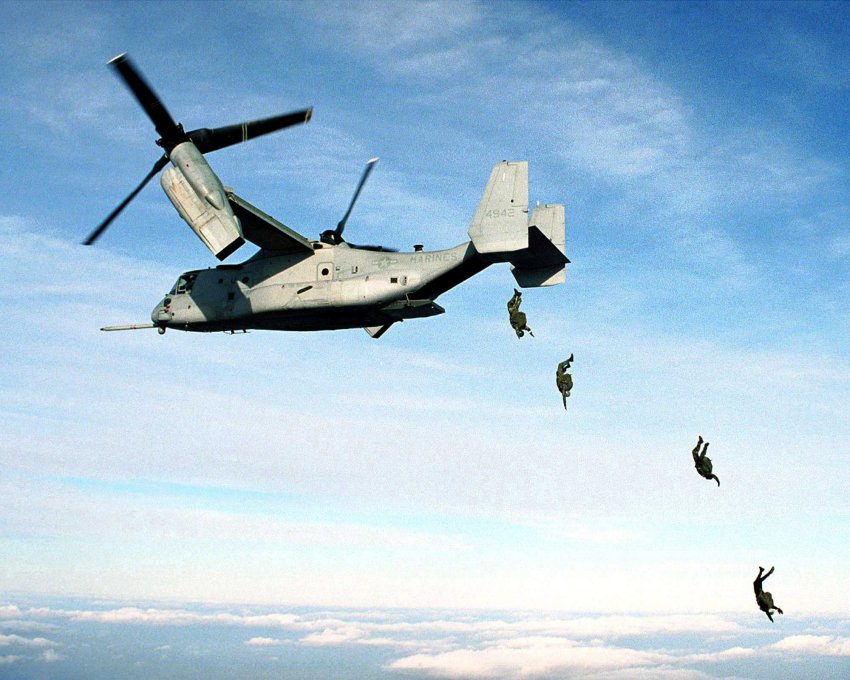
The United States Army selected Bell Textron’s tiltrotor V280 as its Black Hawk replacement last year. This caused more than a few eyebrows to rise.
The V-22 Osprey tiltrotor, flown by the Marine Corps and Special Operations Command, has had a patchy record. It has maintained a keen following and a tendency to kill its users. To date, no one has been held to account for what would, in any other context, be deemed criminal negligence.
The V-22 platform was the first tiltrotor deployed by the US military: it combines the characteristics of fixed-wing planes, helicopters and vertical take-off and landing craft.
It was originally inspired by a Pentagon request to Bell and Boeing, after the Carter administration in 1980 failed in its hostage rescue effort of US citizens being held by Iranian authorities, which led to the deaths of five air force personnel and three marines.
The platform is slated for flying till 2055. Prior to 2007, it had had four crashes, resulting in 30 deaths. Two of the first five prototypes suffered a number of fatal crashes in the early 1990s resulting in 30 deaths, though it formally came into the service of the Marines in 2007. After 2007, there were another 24 deaths in 10 more crashes.
The Marine Corps has persisted with its use because it is seen as critical to the new “lighter” Force Design 2030 version of conflict, characterised by manoeuvrability and speed.
“Proponents of Force Design 2030 argue,” wrote ground forces specialist Andrew Feickert, “that current Marine Corps design is outdated and that new forces and operational concepts are required to prevail against China”.
One such operational concept is Expeditionary Advanced Base Operations (EABO). It has been embraced by the US Marine force located in the Northern Territory, described as the Marine Rotational Force – Darwin. The unit, comprising 2500 soldiers, has been based in the Northern Territory from April to October every year since 2012.
On the morning of August 27, a V-22B Osprey with 23 US marines crashed on Melville Island, just north of Darwin. Three marines were killed. Several others were left injured with varying degrees of severity.
The episode brought back memories of another Osprey crash on Australian soil, when a Marine Medium Tiltrotor Squadron 265 failed to land on the flight deck of USS Green Bay on August 5, 2017. Three people died, and 23 were injured.
Those with claimed military or aviation expertise are still defending the “revolutionary design” of the “plane-helicopter hybrid”. As Peter Layton wrote in The Conversation, it involves wings tilting upwards “for take-off and landing and back down again for level flight”.
It appeals to the Marine Corps for having greater range than helicopters, with higher speed and formidable carrying capacity. “The Osprey is at the leading edge of aviation technology, with nothing else in operational service like it,” Layton said, going on to note its essential role in the US strategy of prosecuting EABO operations against China from US bases in Australia.
The literature about the V-22 Osprey notes the thorny history of this supposed “dream machine” and the problems of the Major Defense Acquisition Program that brought it into existence.
Richard Whittle, writing on the problem-plagued machine, found that, no matter what he penned, he “could usually count on being chastised by someone, for the Osprey was as close as a defense issue gets to being a religious question. There were believers and nonbelievers, and neither had much use for those who gave credence to the other side.”
Believers, such as Layton, assert that each “Osprey flight is a learning event for the pilots, the maintenance personnel and the aircraft’s manufacturer”. This begs the question as to whether such equipment should ever see the light of day, especially given how often the lives of its users are snuffed out.
Other reasons for its dangerous record are also offered to distract from this deeply flawed offensive craft. The National Commission on Military Aviation Safety, in a 2020 study conducted at the behest of US Congress, noted the baleful safety record of the US military.
The audit found that between 2013 and 2018, US forces suffered a remarkable 6000 aviation safety “mishaps” during training and routine operations: they led to 198 deaths and 157 lost aircraft.
The bill for this dubious achievement had been US$9.41 billion. The Osprey, it would seem, found itself in good, perishable company.
As with other matters deemed to be above question, those saddled with it have paid the highest price.
As the US military continues its inexorable march to the next war, this time using its Australian bases with government support, it looks like it will happily continue to place its own personnel in machines as deadly to them as to any intended adversary.
[Binoy Kampmark currently lectures at RMIT University.]